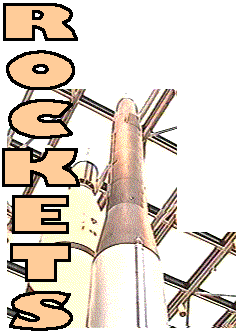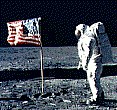
There is a Chinese story of a legendary government official Wan-Hoo who equipped a chair with 47 large rockets, hoping it would take him to the moon. His 47 assistants ignited the rockets with torches. An enormous explosion followed. When the smoke cleared Wan-Hoo and the chair were gone never to be seen again.
The ancient Chinese, and the ancient Greeks, were familiar with the action-reaction principle, now called Newton's Third Law. An object, such as a rocket can push itself forward, against the inertia of the material that it ejects.
We have all had fun letting go air filled balloons, which propel themselves against the escaping air. A more elaborate version of this idea is a soda bottle rocket filled with compressed air. Check out the bottle rocket instructions presented by no less an authority on rocket flight than NASA.
Unlike airplanes that need air for lift and for oxygen, rockets (or firecrackers) carry their own oxygen and their fuel. They are completely self-sufficient and can propel themselves through vacuum.
Chinese rocketry was supported by another of their clever inventions. Several hundred years B.C. the Chinese invented gunpowder, a mixture of charcoal, sulfur and saltpeter (Potassium Nitrate KNO3.) Many practical applications quickly followed, including fireworks and "fire arrows", bamboo tubes filled with gunpowder. The tubes were made sturdy enough to propel themselves against the exhausted gas, rather than exploding like a grenade.
Rocketry ideas took more than a thousand years to reach Europe. Reports of rocket use by the Mongols date from the 13th century. Seven centuries later, Wan-Hoo's dream became a reality when on July 20, 1969, the first astronauts rode powerful rockets to the Moon.
Until 1926, rockets were propelled by solid fuel, the first example being gunpowder used by the Chinese. Solid fuels still service powerful modern rockets, such as the Space Shuttle boosters. Solid fuels are mixtures of several chemical compounds, the primary being the fuel and the oxidant. In gunpowder the fuel is charcoal (carbon) and the oxidant is potassium nitrate. Solid fuel rockets are simple, easy to store and maintain, but they produce relatively low thrust that is not adjustable. Once ignited, solid fuel will burn until the fuel is consumed and the burn rate cannot be controlled. Nevertheless, solid fuel missiles are heavily used in the military where ease of use frequently outweighs the disadvantages.
The flexible rockets that underpin the space program use liquid fuels. Both the fuel and the oxidizer are liquid. The fuel and the oxidizer are carried in separate containers because they usually react on contact. They are often highly volatile and are therefore loaded just before launch to prevent excessive losses. Liquid hydrogen is an example of a liquid fuel. Liquid oxygen and hydrogen peroxide are examples of liquid oxidizers. Liquid fuel rockets deliver huge thrusts. The fuel-oxidizer mix is controlled, giving these rockets a great deal of flexibility. Without complex liquid fuel rocket technology there would have been no space program.
A Quick Rocketry Timeline
- 200 B.C. "Fire Arrows", bamboo tubes powered by gunpowder, are used by the Chinese military.
- 1200's
- Rocket weapons are used in the siege of Budapest.
- Arabs use rockets against the French in the Seventh Crusade.
- 1500's
- Italian military add rockets to their weapons arsenals.
- Rockets are used by the French in the Hundred Years War.
- 1800's
- The British create a rocket brigade.
- Rockets cross the Atlantic to the Americas.
- Whalers develop rocket-powered harpoons with explosive tips.
- 1900's
- During the First World War the French use aerial rockets (rockets shot from airplanes) against observation blimps.
- 1920's

- Robert Goddard in the United States, Wernher von Braun in Germany, and rocket pioneers elsewhere, experiment with liquid fuel rockets.
Goddard was attracted to the idea of space flight as a teenager when he read H.G.Wells's book
The War of The Worlds. His rocketry experiments became serious when he was studying for his doctorate at Clark University where there is a Goddard web site.
- March 16, 1926:Goddard flies the first ever liquid fuel powered rocket. The 152 feet flight can be considered the birth of the space age.
Goddard's picture courtesy of NASA
- 1930's
- The German Army creates an army rocket research group.
- December 1934 Wernher von Braun flies an A-2 rocket, powered with ethanol and liquid oxygen.
- A-2 evolves into V-2, the first practical rocket weapon.
- The Germans move rocket operations to Peenmünde, an island in the Baltic sea. Rockets are now a serious weapon.
- 1940's

- October3, 1942:A guidedV-2 rocket hits its target 120 miles from Peenmünde. The Germans hope to use V-2's against targets in England.
- May 2, 1945:Wernher von Braun and his team surrender to American forces in Germany.
- United States Army establishes a rocketry research center at Cuxhaven in Germany from where several experimental V-2's are launched.
- April 16, 1946:The first V-2 launch from White Sands New Mexico, von Braun's new base of operations.
- 1950's
- The Army's missile program is moved to Huntsville, Alabama.
- Von Braun now leads the Army Ballistic Missile Agency at Redstone Arsenal.
- In 1958 Jupiter C, a Redstone rocket, launches America's first satellite, Explorer I.
- Redstone rockets launch Shepard and Grissom into suborbital flights.
- 1958:NASA is established. Von Braun and his team become the nucleus of the US space program. The Army Missile Command takes over the Redstone Arsenal and continues its missile program.
- 1960's: Going to the Moon!

- 1961:President Kennedy challenges the nation to put the first man on the moon.
- Saturn rockets are developed at NASA's Marshal Space Flight Center to fly the Apollo Program astronauts.
- July 20, 1969:Edwin Aldrin salutes the flag on the moon.
The picture (courtesy of NASA) was taken by Neil Armstrong, the first man on the moon.
After a successful rocket trip to the moon and back, NASA and the astronauts change their goal from travel into space to work in space. Rockets become a vehicle to move people and instruments around in space.
- 1970's: working in space

Following a pause in the space shuttle project after the Challenger explosion the program resumes in 1988. Numerous scientific and technical equipment is now in orbit, from communication satellites to the Hubble telescope. Astronauts, transported out there by powerful rockets are learning to work in space, performing complicated technical tasks, such as the repair of the Hubble.
Ever more sophisticated equipment is ferried into space, such as the Chandra X-ray telescope placed in orbit on July 22, 1999.
(The picture of STS-93 Space Shuttle on the launch pad courtesy of NASA.)
Further study links:
History
1.  2.
2.  3.
3. 
Space Physics
4.  5.
5.  6.
6. 
Space Program
4.  5.
5. 
Model Rocketry
6.  7.
7.  8.
8. 
Rocket Types
9. 
Further Study Questions:
- What fuel and the oxidizer did Goddard use in his first liquid fuel rocket?
- What was the thrust of the rocket that took the first astronauts to the moon? Was this a liquid fuel or a solid fuel rocket?
- What are some typical thrusts of hobby model rockets?
- If you were to make a Wan-Hoo chair with toy rockets, about how many would you need to lift yourself seated in the chair?





 2.
2.